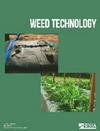鹅草对topamezone和百菌清联合用药的反应评价
IF 1.7
3区 农林科学
Q3 AGRONOMY
引用次数: 0
摘要
摘要目前在匍匐生长的弯草类草坪草中,用于防治鹅草的除草剂很少。Topramezone可以控制鹅草,并被标记为用于匍匐的弯曲草,但潜在的伤害风险导致许多草坪管理者经常以低剂量使用它。这一应用实践增加了将topamezone处理与杀菌剂处理混合使用的可能性。以前的研究发现,杀菌剂可以降低某些除草剂的活性,但它们对topamezone功效的影响尚不清楚。2021年,在弗吉尼亚州的布莱克斯堡和新泽西州的北不伦瑞克之间建立了四项研究,以确定百菌清是否会减少topamezone对鹅草的控制。在受控环境剂量反应研究中,当向混合物中添加百菌净(7,400 g ha - 1)时,将鹅草生物量减少50%所需的topamezone的量从3.04 g ha - 1增加到5.27 g ha - 1。在田间试验中,施用3.7和6.1 g ha - 1的topamezone在处理后42 d对鹅草的控制效果分别为50%和63%。单投加百菌清和投加酸苯并- s -甲基百菌清可将鹅毛草的防治率分别从73%降低到52%和45%。从这些研究中,我们可以得出结论,当以最大允许剂量(6 g / h - 1)或更少施用topamezone时,百菌清有可能减少鹅毛草的防治。这是首次报道杀菌剂在草坪草系统中降低除草剂杂草控制效果。本文章由计算机程序翻译,如有差异,请以英文原文为准。
Evaluation of goosegrass response to combinations of topramezone and chlorothalonil
Abstract Few herbicides are registered for goosegrass control in creeping bentgrass turfgrass. Topramezone controls goosegrass and is labeled for use on creeping bentgrass, but potential injury risks lead many turf managers to frequently apply it at a low-dose. This application practice increases the likelihood that topramezone treatments will be mixed with fungicide treatments. Previous research found that fungicides can reduce the activity of some herbicides, but their effects on topramezone efficacy are unknown. Four studies were established between Blacksburg, VA, and North Brunswick, NJ, in 2021 to determine whether chlorothalonil reduces goosegrass control from topramezone. In controlled environment dose-response studies the amount of topramezone needed to reduce goosegrass biomass by 50% increased from 3.04 g ha −1 to 5.27 g ha −1 when chlorothalonil (7,400 g ha −1 ) was added to the mixture. In field experiments, topramezone at 3.7 and 6.1 g ha −1 controlled goosegrass by 50% and 63%, respectively, at 42 d after treatment when averaged across herbicide admixtures. The addition of chlorothalonil alone and chlorothalonil plus acibenzolar-S-methyl to topramezone reduced goosegrass control from 73% to 52% and 45%, respectively, when averaged across topramezone rate. From these studies we can conclude that chlorothalonil has the potential to reduce goosegrass control when topramezone is applied at the maximum allowable rate (6 g ae ha −1 ) or less. This is the first report of fungicides acting to reduce herbicidal weed control efficacy in turfgrass systems.
求助全文
通过发布文献求助,成功后即可免费获取论文全文。
去求助
来源期刊

Weed Technology
农林科学-农艺学
CiteScore
2.90
自引率
21.40%
发文量
89
审稿时长
12-24 weeks
期刊介绍:
Weed Technology publishes original research and scholarship in the form of peer-reviewed articles focused on understanding how weeds are managed.
The journal focuses on:
- Applied aspects concerning the management of weeds in agricultural systems
- Herbicides used to manage undesired vegetation, weed biology and control
- Weed/crop management systems
- Reports of new weed problems
-New technologies for weed management and special articles emphasizing technology transfer to improve weed control
-Articles dealing with plant growth regulators and management of undesired plant growth may also be accepted, provided there is clear relevance to weed science technology, e.g., turfgrass or woody plant management along rights-of-way, vegetation management in forest, aquatic, or other non-crop situations.
-Surveys, education, and extension topics related to weeds will also be considered
 求助内容:
求助内容: 应助结果提醒方式:
应助结果提醒方式:


